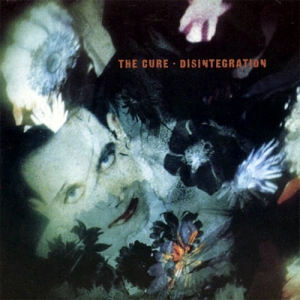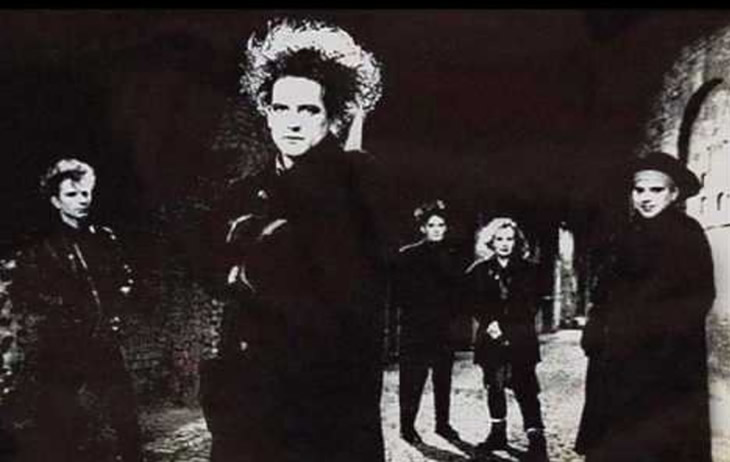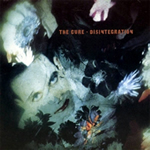Disintegration by The Cure
 Through most of their first decade, The Cure was a group that was always on the razor’s edge of change making them one of the rare “alternative” bands which were actually “alternative”. With Disintegration, their eighth studio album, the group made a slight turn back towards the introspective Gothic rock they had forged in their early years but added a more mature perspective to the mix. The album was composed by front man Robert Smith and grew out of a depression as he faced the realization of turning thirty years old. It was also a concerted effort by Smith to re-discover the soul of the band, which he believed was lost in the recent wave of commercial success.
Through most of their first decade, The Cure was a group that was always on the razor’s edge of change making them one of the rare “alternative” bands which were actually “alternative”. With Disintegration, their eighth studio album, the group made a slight turn back towards the introspective Gothic rock they had forged in their early years but added a more mature perspective to the mix. The album was composed by front man Robert Smith and grew out of a depression as he faced the realization of turning thirty years old. It was also a concerted effort by Smith to re-discover the soul of the band, which he believed was lost in the recent wave of commercial success.
The Cure’s roots stretch back to 1973 when Smith formed his first group with Laurence Tolhurst, while in middle school. With the emergence of punk rock in 1977, the remnants of this group became known as “Easy Cure” and added lead guitarist Porl Thompson. A year later, The Cure were signed to the newly formed English label Fiction, and they released their debut single at the end of 1978, followed by their debut album Three Imaginary Boys in May 1979, which did well critically and commercially. Through the early 80s, the band shied away from overt commercial efforts, with more sombre music that found a niche crowd. In 1987, The Cure released the musically eclectic double Kiss Me, Kiss Me, Kiss Me, which sprang them back towards commercial success reaching the Top 10 in several countries. This was followed by a world tour which exposed some internal friction. Tolhurst became substance dependent and was eventually fired and replaced by keyboardist Roger O’Donnell, while Smith had developed a distaste for the group’s new found popularity.
When the group convened to rehearse for this new album, Smith played demos for his band mates that he was prepared for them to reject. He had already started making plans to record the material as a solo album, but was pleasantly surprised when the group liked the demos. By the end of the pre-production session, The Cure recorded over thirty songs. However, the final album was a bit of a shock to their American label Elektra Records, who expected a further migration towards pop/rock and requested a delayed release date because they believed the record was “commercial suicide”. In spite of these fears, Disintegration became the band’s commercial peak and remains The Cure’s highest selling record to date.
Setting the pace for the album with deep, multi-layered synths and slow, methodical beats, the album’s opening track “Plainsong” is soon joined by a droning guitar riff in the elongated intro, which lasts over two and a half minutes or half the overall song length. While Smith wrote all of the lyrics on the album, he acknowledges the significant musical contributions by the rest of the band, which forge the texture and mood that dominates tracks such as this one. “Pictures of You” is built on masterfully sonic guitar riffs by Thompson and a steady bass by Simon Gallup before the mood rises like a sunrise and the song steps up to the next level with the vocals in this steady and romantic song, which was a minor hit in spite of its seven minute running length. The album then returns to the heavy-synth goth rock with “Closedown”, featuring a rolling drum beat by Roger O’Donnell and only a single verse to break up the emotional groove.
Smith originally wrote “Lovesong” as a private wedding present for his fiance, Mary, but included it on this “dark” album as a concerted counterpart to the rest of the material. Here he certainly succeeded as the song contains a danceable groove, melodic riffs, accessible lyrics, and the perfect pop running time of three and a half minutes (extremely short for this album). A calm organ riff along with an animated bass drives the song with some orchestral keyboards runs between verses and a good guitar lead in the middle. The song was popular worldwide and reached #2 in America, becoming their highest charting single in the U.S.
The tracks which follow “Lovesong” on the album were also popular radio hits. “Last Dance” has some strong guitars, which arrive after synth intro. However, while Smith carries a strong melody throughout the track, the music is quite timid and does not keep up with the mood. “Lullaby” starts with an upbeat, bouncy guitar and bass riff which is soon joined by a strong drum beat by Williams during the intro. Smith’s breathy and desperate vocals are a unique contrast to the hipper mood of the music, and when O’Donnell’s fine keyboards join the mix, the Cure have a top notch music track. “Lullaby” was the group’s highest charting hit in the U.K., reaching #5 on the charts. “Fascination Street” is almost like the second part of “Lullaby” in the sense that it contains the same chord structure and nearly the same tempo (and was the replacement for “Lullaby” as the lead single in America). However, the vocal and melody approach is quite different, being more forthright and eighties twang.
The latter part of the album contains five consecutive songs which top six minutes in length. “Prayers for Rain” contains well processed guitars in the distance before some fine drums cut in to add a majestic effect, painting a scene of grandeur. Lyrically, this song is a sneak peak at the emotive American grunge which would soon arrive. “The Same Deep Water as You” is a long and moody ballad, almost in the same vein as “Riders on the Storm” by The Doors, and even contain similar rainstorm sound effects. The title track, “Disintegration”, is a more upbeat with wild sounds throughout, where “Smith showcases his own lead guitar talents. “Homesick” is the best of this lot, with a sound that is at once eerie and beautiful. Its long intro begins with a soft acoustic and minor-key piano before being joined by Gallup’s animated bass, Williams’ fine, rock-oriented drums and the flanged out guitar of Thompson. In spite of its name, the song’s lyrics tell of avoidance of home and responsibility, like a late night drunken stupor. An accordion introduces the “Untitled” closing track before it all breaks into a decent dance groove, almost funky but slower, as the album departs on an upbeat note.

Smith was distraught that the success of Disintegration further elevated The Cure as a “stadium rock band” and this album’s title seemed prophetic as the band began to slowly fall apart. While different lineups continued the group through the 1990s, this was the end of their golden era.
~
Part of Classic Rock Review’s celebration of 1989 albums.






